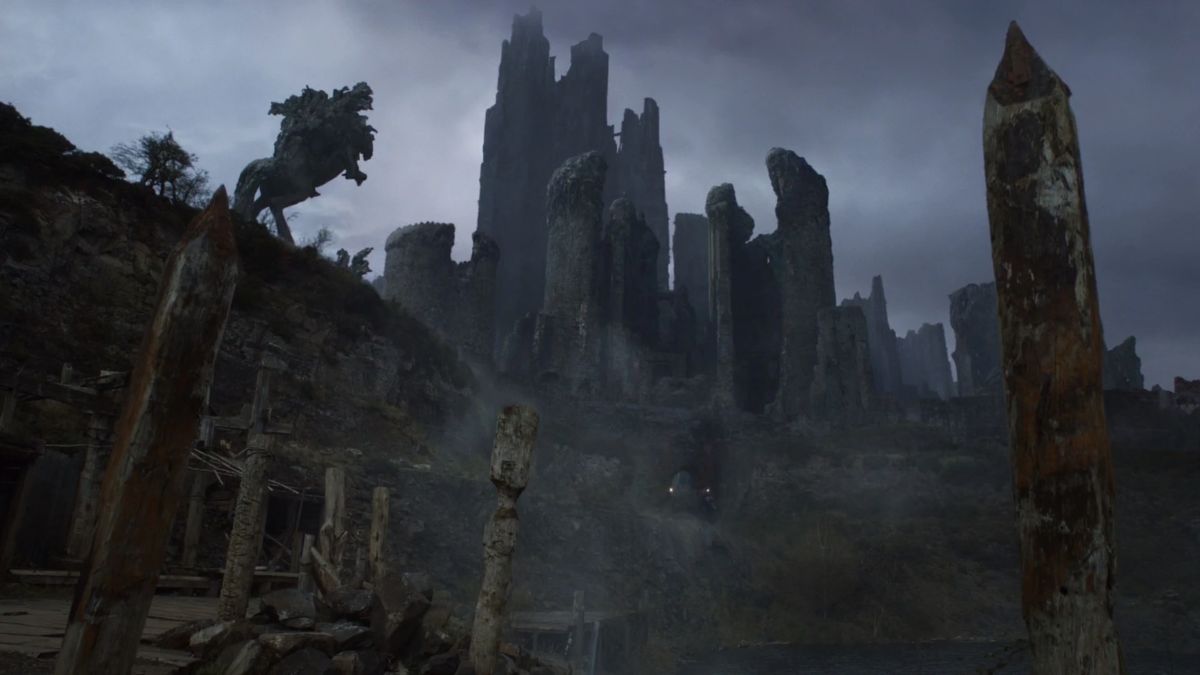Turning Harrenhal Into a Literal Haunted Castle Is One of The Best Decisions ‘House of the Dragon’ Could Have Made
I just love that creepy cursed castle.

One of the major arcs of this second season of House of the Dragon so far is Daemon taking up residence in Harrenhal.
This move comes with the explicit goal of bringing the various river lords over to Rhaenyra’s cause (and using their armies against the Greens’) and the more implicit one of putting some distance between himself and his wife after she pretty much kicked him out of Dragonstone in episode 2. The reason being that little incident known as Blood and Cheese.
Except that Harrenhal is a castle unlike any other in the Seven Kingdoms, and not just because it’s the largest in the realm. We see Daemon immediately feel ill at ease in this enormous, humid castle—filled with voices and whispers and women who are probably witches. He starts having visions pretty much right away, tormenting him with people from his past he clearly has unresolved feelings for. And we can’t really pinpoint why he’s having them. They could be a “simple” manifestation of his guilt or be caused by Alys Rivers, or be a consequence of Harrenhal’s curse and the general creepiness that floats throughout the Riverlands like mist—or maybe a combo of all four.
I think that’s a brilliant narrative choice—independently of my opinions about Daemon and about his fight with Rhaenyra. While it seems like he’s not doing anything consistent besides being in his Macbeth era and constantly being bloodlet by Alys so that she can continue to give him traumatizing visions, it’s actually a great chance to explore his character and dive into who he is as a person as well as the perfect way to bring in all the more magical features of A Song of Ice and Fire, which usually get somewhat sidelined in favor of the political intrigue.
And that includes the possibility of really diving into what has to be one of the most fascinating locations in this entire narrative universe. Both inside the story and outside.
In-universe, Harrenhal is pretty much the embodiment of human hubris. Harren the Black of House Hoare, then the Kings of the Isles and Rivers, decided to build this sprawling castle as a monument to himself and make it the most impregnable fortress of the continent. Then again, there aren’t many walls able to withstand dragonfire—on the day that Harren and his family took up residence at Harrenhal after its forty years of construction, Aegon the Conqueror flew over to the riverlands and unleashed the fire of his dragon Balerion over the castle. Castle which promptly melted away—assuming the look it has today, with its five towers almost looking like half-burned candles—burning Harren and the entirety of House Hoare in the process.
And yet at the same time, Harrenhal arguably remains the most formidable castle in the realm, presiding over vast and rich lands and with the capacity to host a very large garrison. Still, forming that garrison would prove too costly, as would properly maintaining the castle which as we saw in House of the Dragon leaks everywhere—a perfect representation of tragic irony.
But the fate of Harren the Black isn’t the only thing that gives Harrenhal its infamous reputation and that makes everyone in the realm believe it’s cursed—it’s also how the castle was constructed. Thousands of imprisoned smallfolk died during the forty years it took to raise Harrenhal up. The weirwoods that had stood there and on the isle of the Gods Eye—where the pact between the First Men and the Children of the Forest was signed—for millennia were cut down to use in the castle. Rumors have it that Harren ordered human blood to be mixed in the mortar for the stonework.
These are all things that lead the rest of Westeros to believe that Harrenhal is cursed. And whether or not the curse is real, the fact remains that there isn’t a single family that has held Harrenhal that hasn’t been completely wiped out in a wide variety of painful and gruesome ways.
At the same time, Harrenhal is incredibly fascinating also as a narrative device. Harrenhal is a brilliantly constructed microcosm of feudalism, which is what holds Westeros in a chokehold and makes pretty much everyone living in it some degree of miserable and wretched. It’s a monument to feudal violence in that it’s a castle made of peasant blood, built by stripping the lands around it of all resources and carelessly ignoring its most sacred features. And that castle continuously keeps eating people, the small folk and the nobles who try to hold it to climb up the ranks of Westerosi aristocracy alike. It’s the embodiment of a never-ending cycle of violence that in-universe has gone on for centuries but where ultimately nothing changes—a lord moves in, people die, a new lord moves in, more people die, and so on.
What makes this all particularly interesting—and brilliantly written—however is the fact that all castles are Harrenhal to the smallfolk of Westeros. All castles are built and maintained with their blood and suffering to some degree, all castles swallow people and never let them go. Harrenhal is called cursed because it does the same thing to nobles—because again, feudalism crushes everyone alike, even though of course nobles can delude themselves that they are actually winning the game.
It’s brilliant, it’s creepy, it’s my favorite part of each episode and I hope it never ends—even though of course it will have to end at some point. And to those who have read Fire & Blood and know what comes after Daemon’s permanence at Harrenhal, I hope you agree with me in saying that if this is the premise then we have an incredible season 3 ahead of us.
Have a tip we should know? tips@themarysue.com